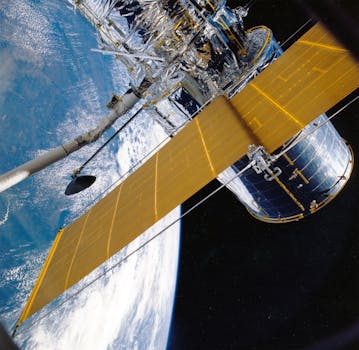GEO Satellites: Understanding the Technology and Applications of Geostationary Orbit Satellites

GEO Satellites: Understanding the Technology and Applications of Geostationary Orbit Satellites
GEO satellites, or geostationary orbit satellites, are a type of satellite that orbits the Earth at an altitude of approximately 36,000 kilometers, which is about 1/10th of the way to the Moon. At this altitude, the satellite’s orbital period matches the Earth’s rotational period, allowing it to remain stationary in the sky. GEO satellites are a crucial part of modern satellite technology, providing a wide range of applications and services, including telecommunications, weather forecasting, and navigation.
The concept of a geostationary orbit was first proposed by science fiction writer Arthur C. Clarke in 1945, and the first geostationary satellite, Syncom 2, was launched in 1963. Since then, the technology has evolved significantly, with thousands of GEO satellites launched into orbit. These satellites have revolutionized the way we communicate, navigate, and understand our planet.
How GEO Satellites Work
GEO satellites work by transmitting and receiving signals to and from Earth-based stations. The signals are transmitted through a large antenna on the satellite, which is pointed towards the Earth. The signals are then received by a network of ground stations, which decode and distribute the information to the intended users. The satellite’s high altitude and stationary position allow it to provide coverage to a large area of the Earth’s surface, making it ideal for applications such as telecommunications and broadcasting.
One of the key advantages of GEO satellites is their high bandwidth capacity, which allows them to transmit large amounts of data quickly and efficiently. This makes them ideal for applications such as video conferencing, online gaming, and cloud computing. Additionally, GEO satellites are relatively low-cost compared to other types of satellites, making them an attractive option for many organizations and governments.
Applications of GEO Satellites
GEO satellites have a wide range of applications, including telecommunications, weather forecasting, navigation, and Earth observation. In the field of telecommunications, GEO satellites are used to provide internet connectivity, mobile phone networks, and television broadcasting. They are also used for navigation, providing location information and timing signals for GPS and other navigation systems.
In the field of weather forecasting, GEO satellites are used to monitor cloud patterns, sea surface temperatures, and other weather-related phenomena. This information is used to predict weather patterns and provide early warnings for severe weather events. GEO satellites are also used for Earth observation, providing high-resolution images of the Earth’s surface and monitoring environmental changes such as deforestation and ocean pollution.
Challenges and Limitations of GEO Satellites
Despite the many advantages of GEO satellites, there are also several challenges and limitations to their use. One of the main challenges is the high cost of launching a GEO satellite into orbit, which can range from $50 million to $500 million or more, depending on the size and complexity of the satellite. Additionally, GEO satellites are vulnerable to space debris and other hazards, which can damage or destroy the satellite and disrupt its operations.
Another limitation of GEO satellites is their relatively narrow field of view, which can make it difficult to provide coverage to areas with high population densities or complex terrain. Additionally, GEO satellites are subject to signal delay, which can range from 250 to 300 milliseconds, depending on the location of the satellite and the user. This can make it difficult to use GEO satellites for applications that require real-time communication, such as video conferencing or online gaming.
Future of GEO Satellites
Despite the challenges and limitations of GEO satellites, they are likely to continue playing a major role in modern satellite technology. Advances in technology are making it possible to launch smaller, more efficient satellites into orbit, which is reducing the cost and increasing the capabilities of GEO satellites. Additionally, the development of new propulsion systems and other technologies is making it possible to extend the lifespan of GEO satellites and improve their overall performance.
In the future, we can expect to see even more innovative applications of GEO satellites, including the use of satellite constellations to provide global coverage and the development of new technologies such as quantum communication and satellite-based internet of things (IoT) networks. As the demand for satellite-based services continues to grow, the importance of GEO satellites will only continue to increase, making them a vital part of our global communication and navigation infrastructure.


